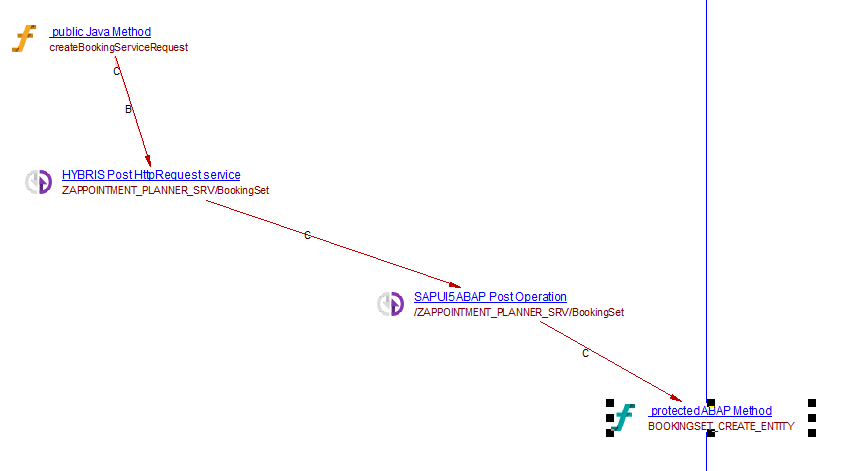SAP Hybris - 1.0
Extension ID
com.castsoftware.sap.hybris
What’s new?
See Release Notes.
In what situation should you install this extension?
If your application source code uses the SAP Hybris framework you should install this extension.
This extension provides support for the Hybris framework (java package com.hybris.ymkt.common.http). The analysis of your JEE application will be enriched with modelling of the HTTP API created with Spring MVC. This will allow the resolution of transactions starting in a client application which uses these API (web app for instance) to be traced into the backend application.
- The extension creates Hybris HttpRequest services which represent end-points of transactions when they are not connected to an operation on an ABAP server side (analyzed by the ABAP analyzer).
- JEE is acting here as the client of an ABAP server.
Application configuration
In an xml file present in a “resources” folder, we have beans with property name equal to “oDataService”. The extension will focus on these particular beans, for example:
<beans xmlns="http://www.springframework.org/schema/beans"
xmlns:xsi="http://www.w3.org/2001/XMLSchema-instance"
xmlns:aop="http://www.springframework.org/schema/aop"
xsi:schemaLocation="http://www.springframework.org/schema/beans
http://www.springframework.org/schema/beans/spring-beans.xsd
http://www.springframework.org/schema/aop
http://www.springframework.org/schema/aop/spring-aop.xsd">
...
<bean id="bookingDetailsODataService" parent="oDataServiceCRM">
<property name="rootUrl" value="#{configurationService.configuration.getProperty('crm.odata.booking.url.root')}" />
</bean>
<bean id="bookingODataService"
class="com.company.companyodata.service.impl.BookingODataServiceImpl" parent="AbstractODataService">
<property name="oDataService" ref="bookingDetailsODataService" />
<property name="modelService" ref="modelService"/>
</bean>
....
</beans>
In this xml file, we can see that the “bookingODataService” bean has “oDataService” property ref equal to “bookingDetailsODataService” which corresponds to another bean whose “rootUrl” property is
"#{configurationService.configuration.getProperty('crm.odata.booking.url.root')}".
We can also see that this bean is connected to the “com.company.companyodata.service.impl.BookingODataSeviceImpl” java class. This url will be the root url of http services that the extension will create for the class “com.company.companyodata.service.impl.BookingODataSeviceImpl”. This root url is defined through a property which can be found in a “project.properties” file - note that the “${CRM_ODATA_URL}” part will be removed from url:
...
crm.odata.booking.url.root=${CRM_ODATA_URL}/ZAPPOINTMENT_PLANNER_SRV/
...
Application analysis
The extension will take into account the following Java code:
package com.company.companyodata.service.impl;
import com.hybris.ymkt.common.http.HttpURLConnectionRequest;
import com.hybris.ymkt.common.http.HttpURLConnectionResponse;
public class BookingODataServiceImpl extends AbstractODataService implements BookingODataService
{
public String createBookingServiceRequest(final CsTicketModel csTicketModel)
throws IOException, EdmException, EntityProviderException
{
...
final URL url = getoDataService().createURL(companyodataConstants.BOOKING_HEADERSET);
final HttpURLConnectionRequest request = new HttpURLConnectionRequest(companyodataConstants.HTTP_METHOD_POST,
url);
...
}
}
The extension focuses on “createUrl” and “HttpURLConnectionRequest” in order to create http resources. The “url” variable is evaluated and the url root (mentioned previously) is added to it as a prefix.
Below is an example of what is obtained after an analysis. The “Hybris Post Http Request service” has been created by the extension with the call link from the java method to the request service. The part on the right is created by the ABAP analyzer, and the link between the Hybris object and the ABAP operation is created by the web service linker:

Function Point, Quality and Sizing support
- Function Points (transactions): a green tick indicates that OMG Function Point counting and Transaction Risk Index are supported
- Quality and Sizing: a green tick indicates that CAST can measure size and that a minimum set of Quality Rules exist
| Function Points (transactions) | Quality and Sizing |
|---|---|
| ✅ | ❌ |
Compatibility
| Release | Operating System | Supported |
|---|---|---|
| v3/8.4.x | Microsoft Windows / Linux | ❌ |
| v2/8.3.x | Microsoft Windows | ✅ |
Dependencies with other extensions
Some CAST extensions require the presence of other CAST extensions in order to function correctly. The SAP Hybris extension requires that the following other CAST extensions are also installed:
- JEE Analyzer
- Web Services Linker
- com.castsoftware.internal.platform (internal extension)
What results can you expect?
Objects
| Icon | Description |
|---|---|
 |
HYBRIS Get HttpRequest service |
 |
HYBRIS Post HttpRequest service |
 |
HYBRIS Put HttpRequest service |
 |
HYBRIS Delete HttpRequest service |
Transactions
Get, Post, Put and Delete HttpRequestService objects are transaction end-points except if they are calling an external object (an object belonging to a server: ABAP operation in this case).